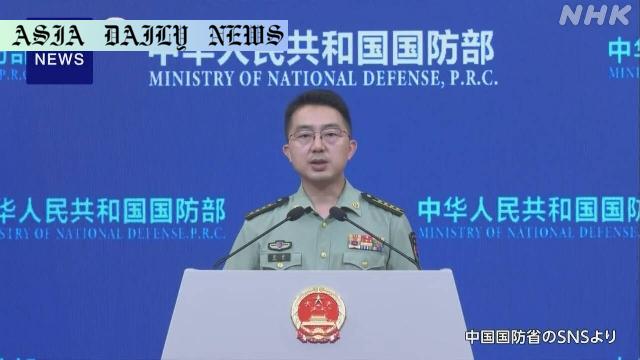Aerial Encounters: Japan reports close calls with Chinese jets in Pacific, sparking diplomatic friction amidst escalating tensions.
Japan reports close aerial encounters with Chinese jets on June 7 and 8.
Chinese jets came as close as 45 meters to Japanese planes during the incidents.
Beijing accuses Japan of creating risks and urges to halt provocations.
Japan denies the accusations and demands steps to avoid recurrence.

Aerial Incidents Heighten Regional Tensions
In recent developments that underscore escalating tensions in the Asia-Pacific region, the Japanese Defense Ministry has brought to light a series of close aerial encounters involving Chinese military aircraft. According to officials, incidents on June 7 and 8 saw Chinese fighter jets shadowing Japanese Maritime Self-Defense Force planes, coming as dangerously close as 45 meters over the Pacific Ocean near Japan. These alarming events have prompted a diplomatic exchange between the two nations, as both blame the other for creating safety risks.
Japan’s Concerns Over Safety and Provocation
Japan has conveyed its serious concerns over the proximity of the Chinese jets, emphasizing the risk posed to the safety of its patrol aircraft and military personnel. The Japanese government has formally protested to China, urging concrete measures to ensure such near-miss incidents do not recur. Officials assert that these encounters were unprovoked and are unacceptable, citing endangerment of flight operations and potential escalation that could lead to broader military hostilities.
China’s Retaliatory Accusations
In response, Beijing has issued a stern statement accusing Japan of engaging in what it describes as deliberate provocations. A spokesperson from China’s defense ministry alleged that Japanese vessels and aircraft have been frequently disrupting Chinese military activities, posing reciprocal risks. The diplomatic tone from China has reflected a zero-tolerance policy, with Beijing urging Tokyo to halt all so-called “dangerous and provocative actions.” Analysts suggest that both nations appear determined to defend their claims, complicating efforts to resolve the situation amicably.
Escalation of a Long-Standing Dispute
The incidents are the latest flashpoints in a long-standing dispute between the two regional powers. The Pacific Ocean has been a contested area for years, with both Japan and China maintaining overlapping security interests. Issues such as territorial sovereignty, freedom of navigation, and strategic defense have fueled mistrust between the nations. While the Japanese government remains adamant about countering Chinese military activity in its vicinity, China perceives Japan’s moves as aligning with broader strategies by other nations to constrain its regional influence.
Call for Diplomatic Resolution
While tensions escalate, experts emphasize the need for a diplomatic resolution to avoid unintended consequences. Despite their strong stances, both nations have much to lose from prolonged friction. Economic ties and regional stability are at stake, underscoring the importance of communication and negotiation. Observers hope that an impartial, multilateral approach can bring the two sides together to formulate confidence-building measures to avoid future aerial encounters of this nature.
The Broader Implications
The close encounters between Japanese and Chinese forces also have broader geopolitical implications. As the Asia-Pacific becomes an increasingly contested region, such incidents heighten sensitivities among other allied and neighboring nations. The United States and other countries with strategic interests in the region are likely to closely monitor these developments. At the same time, these events could serve as a wake-up call for enhanced regional security frameworks and cooperation mechanisms.
In light of the current diplomatic impasse, Japan and China must balance national security initiatives with caution to avoid unintentional escalations. Without mutual understanding and constructive dialogue, these aerial encounters could spiral into something far more dangerous, affecting not just the two nations but the broader international community as well.



Commentary
Examining the Growing Tensions
The recent aerial encounters over the Pacific Ocean between Japan and China shine a glaring spotlight on the fragile state of relations between these two significant Asian powers. The reports of Chinese aircraft coming dangerously close to Japanese patrol planes—a mere 45 meters—are indeed concerning. Not only do such incidents pose immediate risks to military personnel, but they also exacerbate existing geopolitical tensions, potentially setting the stage for greater conflict in an increasingly complex regional landscape.
A Collision of National Interests
At the heart of this issue lies a deep-rooted collision of national interests. Japan is geographically situated in one of the most strategically significant yet volatile regions in the world. Its proximity to China, coupled with historical tensions and territorial disputes, has always been a sore point. On the other hand, China views the Japanese military’s presence in the region as an extension of external attempts to contain its ascendancy. This mutual distrust creates a feedback loop of defensive posturing, where one nation’s safeguarding measures are perceived by the other as provocations.
The Path Forward: Communication and Restraint
Resolving such issues demands restraint, diplomacy, and perhaps most importantly, open channels of communication. Both Japan and China must reassess their military strategies near disputed or sensitive zones to minimize the risk of unintended confrontations. Additionally, international mechanisms designed for conflict resolution in such scenarios need to play a more proactive role. Multilateral engagement, involving other stakeholders in the region, could offer an impartial platform for both nations to negotiate and reach common ground.
A Shared Responsibility
The fact that Asia remains one of the most dynamically evolving regions in the world carries immense responsibility. Nations like Japan and China must act as stabilizing forces rather than catalysts of discord. The recent incidents are a stark reminder that peace in the region must never be taken for granted. Instead, it requires constant nurturing through diplomatic efforts, mutual respect, and a shared understanding of the stakes involved. Only by viewing themselves as partners in regional stability can both nations prevent such close encounters from escalating into something far more ominous.